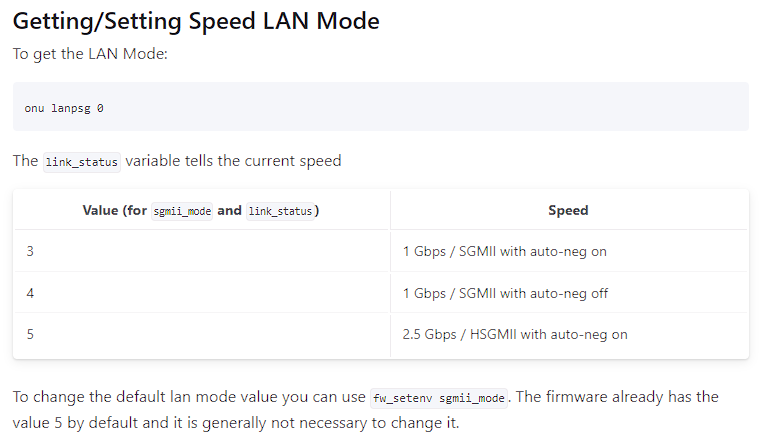Unfortunately, it still doesn’t work.
config interface 'ont'
option device 'eth1'
option proto 'static'
option ipaddr '192.168.20.1'
option netmask '255.255.255.0'
ip a
root@OpenWrt:/# ip a
1: lo: <LOOPBACK,UP,LOWER_UP> mtu 65536 qdisc noqueue state UNKNOWN qlen 1000
link/loopback 00:00:00:00:00:00 brd 00:00:00:00:00:00
inet 127.0.0.1/8 scope host lo
valid_lft forever preferred_lft forever
inet6 ::1/128 scope host
valid_lft forever preferred_lft forever
2: eth0: <BROADCAST,MULTICAST,UP,LOWER_UP> mtu 1504 qdisc mq state UP qlen 1000
link/ether 8e:ed:11:03:87:5c brd ff:ff:ff:ff:ff:ff
inet6 fe80::8ced:11ff:fe03:875c/64 scope link
valid_lft forever preferred_lft forever
3: eth1: <NO-CARRIER,BROADCAST,MULTICAST,UP> mtu 1500 qdisc mq state DOWN qlen 1000
link/ether 8e:ed:11:03:87:5d brd ff:ff:ff:ff:ff:ff
inet 192.168.20.1/24 brd 192.168.20.255 scope global eth1
valid_lft forever preferred_lft forever
4: wan@eth0: <NO-CARRIER,BROADCAST,MULTICAST,UP> mtu 1500 qdisc noqueue master br-wan state LOWERLAYERDOWN qlen 1000
link/ether 8e:ed:11:03:87:5d brd ff:ff:ff:ff:ff:ff
5: lan1@eth0: <NO-CARRIER,BROADCAST,MULTICAST,UP> mtu 1500 qdisc noqueue master br-lan state LOWERLAYERDOWN qlen 1000
link/ether 8e:ed:11:03:87:5c brd ff:ff:ff:ff:ff:ff
6: lan2@eth0: <NO-CARRIER,BROADCAST,MULTICAST,UP> mtu 1500 qdisc noqueue master br-lan state LOWERLAYERDOWN qlen 1000
link/ether 8e:ed:11:03:87:5c brd ff:ff:ff:ff:ff:ff
7: lan3@eth0: <NO-CARRIER,BROADCAST,MULTICAST,UP> mtu 1500 qdisc noqueue master br-lan state LOWERLAYERDOWN qlen 1000
link/ether 8e:ed:11:03:87:5c brd ff:ff:ff:ff:ff:ff
8: lan4@eth0: <NO-CARRIER,BROADCAST,MULTICAST,UP> mtu 1500 qdisc noqueue master br-lan state LOWERLAYERDOWN qlen 1000
link/ether 8e:ed:11:03:87:5c brd ff:ff:ff:ff:ff:ff
9: sfp2@eth0: <NO-CARRIER,BROADCAST,MULTICAST,UP> mtu 1500 qdisc noqueue master br-lan state LOWERLAYERDOWN qlen 1000
link/ether 8e:ed:11:03:87:5c brd ff:ff:ff:ff:ff:ff
10: wlan0: <BROADCAST,MULTICAST> mtu 1500 qdisc noop state DOWN qlen 1000
link/ether 00:0c:43:26:60:00 brd ff:ff:ff:ff:ff:ff
11: wlan1: <BROADCAST,MULTICAST> mtu 1500 qdisc noop state DOWN qlen 1000
link/ether 8e:ed:11:03:87:5e brd ff:ff:ff:ff:ff:ff
19: br-lan: <NO-CARRIER,BROADCAST,MULTICAST,UP> mtu 1500 qdisc noqueue state DOWN qlen 1000
link/ether 8e:ed:11:03:87:5c brd ff:ff:ff:ff:ff:ff
inet 192.168.1.1/24 brd 192.168.1.255 scope global br-lan
valid_lft forever preferred_lft forever
inet6 fdee:7d2b:f512::1/60 scope global tentative noprefixroute
valid_lft forever preferred_lft forever
20: br-wan: <NO-CARRIER,BROADCAST,MULTICAST,UP> mtu 1500 qdisc noqueue state DOWN qlen 1000
link/ether 8e:ed:11:03:87:5d brd ff:ff:ff:ff:ff:ff
and then :
root@OpenWrt:/# ethtool -s eth1 autoneg off
root@OpenWrt:/# ip link set dev eth1 up
root@OpenWrt:/# ip addr show dev eth1
3: eth1: <NO-CARRIER,BROADCAST,MULTICAST,UP> mtu 1500 qdisc mq state DOWN qlen 1000
link/ether 8e:ed:11:03:87:5d brd ff:ff:ff:ff:ff:ff
inet 192.168.20.1/24 brd 192.168.20.255 scope global eth1
valid_lft forever preferred_lft forever
root@OpenWrt:/# ip route
192.168.1.0/24 dev br-lan scope link src 192.168.1.1
192.168.20.0/24 dev eth1 scope link src 192.168.20.1
root@OpenWrt:/# ping 192.168.20.10
PING 192.168.20.10 (192.168.20.10): 56 data bytes
^C
--- 192.168.20.10 ping statistics ---
12 packets transmitted, 0 packets received, 100% packet loss
root@OpenWrt:/# ip addr add 192.168.20.1/24 broadcast 192.168.20.255 dev eth1
ip: RTNETLINK answers: File exists
root@OpenWrt:/# ip route add 192.168.20.0/24 dev eth1
ip: RTNETLINK answers: File exists
result :
root@OpenWrt:/# ping 192.168.20.10
PING 192.168.20.10 (192.168.20.10): 56 data bytes
^C
--- 192.168.20.10 ping statistics ---
6 packets transmitted, 0 packets received, 100% packet loss
root@OpenWrt:/#
